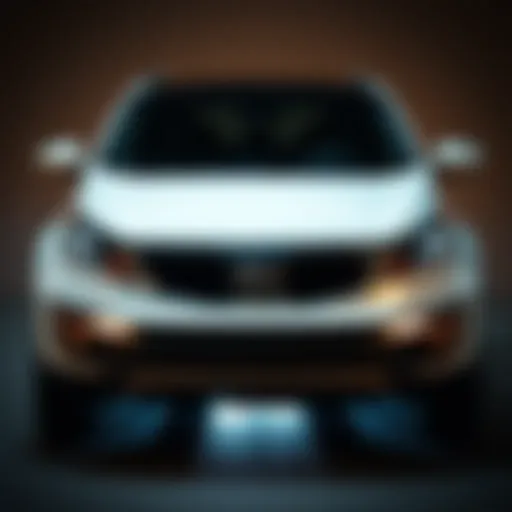Understanding Scratches and Touch-Up Paint Techniques


Intro
Scratches on vehicles and boats aren’t just mere superficial blemishes; they can be symptomatic of deeper issues that require attention. Understanding why these scratches occur and how to effectively address them is essential not only for maintaining aesthetics but also for preserving the value of your investment. This article dives into the nitty-gritty of scratches, their effects on longevity and visual appeal, and equips you with practical touch-up paint techniques. Whether you’re an automotive enthusiast, a proud boat owner, or someone looking to keep your vehicle looking sharp, this guide has you covered.
Scratches can arise from countless situations, be it a brush against a tree while parking or the harsh wear of the marine elements. Knowing the root of these scratches can help in choosing the right preventative measures and repair techniques. As we traverse this subject, you’ll explore the methodological approaches to touch-up painting, materials you might want to consider, and tips that ensure that your finish looks nothing short of professional.
In addition, we will take a close look at why choosing the right product is critical for different surfaces. Scratches may seem minor, but neglecting them could lead to bigger headaches down the road, including corrosion and decreased resale value. With that said, let’s delve into the specifics and see what it takes to not just hide a scratch, but to make it a thing of the past.
Preface to Fahrzeugpflege
In the realm of vehicle and boat maintenance, Fahrzeugpflege emerges as a crucial discipline that goes beyond mere upkeep. Understanding this concept is essential for enthusiasts and everyday users alike, as it encompasses the practices and techniques that preserve and enhance the aesthetics and longevity of these investments. Proper maintenance plays a significant role in not only sustaining the appearance but also in protecting the value of vehicles and boats over time.
Importance of Vehicle Aesthetics
Vehicle aesthetics aren't just superficial; they touch on the very essence of pride and investment in personal or recreational assets. For many, a vehicle isn't just a means to get from point A to point B. It reflects one’s personality and choices. The gloss of a polished car body or the sheen of a well-maintained boat surfaces can say much about the owner’s care and attention.
Maintaining the look of your vehicle can enhance its market value significantly. When it comes time to sell or trade in, buyers often find visual integrity more appealing. Scratches, faded paint, or dull finishes can make a vehicle appear neglected and can drive potential buyers away.
Additionally, fresh and appealing aesthetics can improve the overall experience of driving or boating. Imagine cruising a sleek, shiny boat on water — it adds to the enjoyment of the activity, creating a connection between the user and their vehicle.
Common Causes of Scratches
Scratches can come from numerous sources, and understanding their origins can help in both preventive and corrective actions. Here are some common culprits:
- Environmental Factors: Tree branches, rocks, or even road debris can cause unaesthetic marks on a vehicle's exterior. While these are often unavoidable, they're vital to recognize.
- Improper Washing Techniques: Using abrasive materials or harsh chemicals during cleaning can lead to micro-scratches that accumulate over time, dulling the finish.
- Accidental Bumps: Everyday activities like loading and unloading groceries or bags can lead to unwarranted contact with the vehicle’s surface, resulting in scratches.
- Poor Parking Choices: Tight parking spots can sometimes lead to brushes against walls, guardrails, or other vehicles, creating damage that can be tricky to rectify.
These scratches, while aggravating, are part of vehicle ownership. Recognizing the factors that contribute to them sets the stage for choosing the right touch-up techniques and products, reinforcing the importance of proper maintenance in preserving both the aesthetic and functional integrity of the vehicle or boat.
Understanding Vehicle and Boat Finishes
Understanding the finishes applied to vehicles and boats is crucial for anyone looking to maintain their aesthetic appeal and longevity. The finish not only provides a protective layer against environmental hazards but also plays a significant role in enhancing the visual charm of your automobile or vessel. Selecting the right touch-up techniques and products starts with a firm grasp of these finishes; doing so can prevent further damage while ensuring that repairs blend seamlessly with the existing paintwork.
An awareness of various finishes can influence not just aesthetic considerations but also the methodology for maintenance and repair. Different surfaces—be they metallic or non-metallic, high-gloss or matte—call for distinct approaches during scratch repair. Opting for an unsuitable method or product can lead to mismatched textures and colors, exacerbating rather than alleviating the problem.
In summary, a little knowledge about vehicle and boat finishes affords the owner a significant advantage in their maintenance efforts, ensuring that vehicles or vessels appear sharp and well-cared for.
Types of Paint Used
When diving into the types of paint utilized on vehicles and boats, it’s essential to know that they vary widely in composition and application. Most common paint types include acrylic-based finishes, urethane, and enamels. Each of these types possesses unique properties that affect their performance and durability.
- Acrylic Paint: This type is often favored for its quick drying time and ease of application. It's known for its vibrant colors, although its durability can be lower compared to other options.
- Urethane Paint: Urethane is recognized for its toughness and long-lasting protection against scratches, UV fading, and environmental chemicals. It’s often used in high-end applications.
- Enamel Paint: A classic choice, enamel provides a hard, glossy finish that is resistant to chipping and weathering, making it ideal for boats exposed to harsh marine environments.
Having a firm grasp of these paint types not only aids in selecting the right products for touch-ups but also determines how you will approach surface cleaning and damage assessment. A wrong assumption here can lead you into a paint mismatch nightmare—where you think you're doing good, only to discover the colors don't even come close.
How Finishes Affect Repair Techniques
When it comes to scratching and repairing, the finishes on vehicles and boats are critical. Each finish type creates unique challenges that shape your repair strategy. For example, a metallic finish may hide scratches differently than a matte finish, making it imperative to understand what you’re dealing with before embarking on a touch-up job.
- Metallic Finishes: They reflect light and can make scratches more apparent. While touch-ups may involve blending techniques to match the metallic particles, careful application is crucial to achieve a seamless repair.
- Matte Finishes: This type demands an entirely different approach. A matte finish can be unforgiving—any attempt to apply gloss may fail spectacularly, highlighting imperfections instead of concealing them. Hence, using a matte-compatible product is critical for effective touch-ups.
In practice, how well you execute your repair may depend on how closely you adhere to these principles. If you take shortcuts, especially with application techniques, you may end up setting yourself up for a bigger headache down the line.
Important Note: Always test your selected touch-up paint on a small, inconspicuous area first. This practice can confirm that the finish matches and adheres properly without compromising the existing aesthetic.
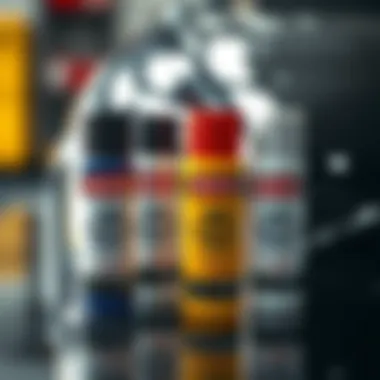
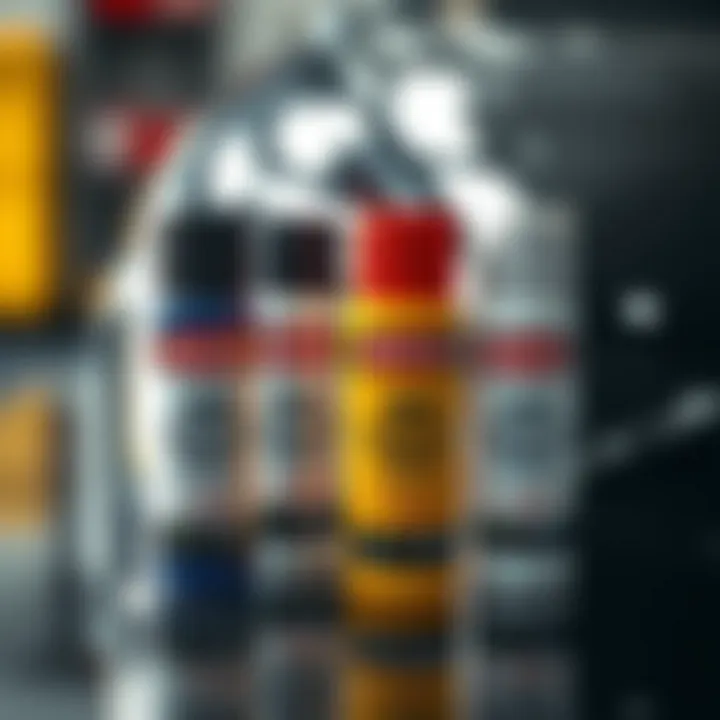
Identifying Scratch Severity
Identifying the severity of a scratch is a critical step in deciding how to approach repairs. Every vehicle owner knows that a scratch, no matter how small, can feel like a thorn in one’s side. However, the severity of the scratch dictates how to treat it, and understanding this aspect can save both time and money in the long run. A well-informed assessment of scratches can help you decide whether a simple touch-up will suffice or if a more extensive repair is in order.
The primary benefit of accurately categorizing scratches lies in the potential to maintain the aesthetic integrity of your vehicle or boat. When left unchecked, minor scratches can turn into deeper issues, creating a snowball effect that may compromise the finish and even lead to rust or other damages underneath.
Minor vs. Major Scratches
Minor scratches are typically superficial, affecting only the top layer of paint. These can often be addressed with simple touch-up kits or compound polishing. The most common types include those caused by debris, light brush strokes, or car wash mishaps. For instance, a faint line from a shopping cart may not warrant a major repair and can often be tackled with a bit of elbow grease and the right product.
On the flip side, major scratches, or those that expose the underlying metal or primer, require more than just a quick fix. They can be quite concerning, as they deepen the potential for corrosion and rust if not addressed promptly. This type of damage is often seen in accidents or when a significant impact occurs. If you find a scratch that reveals the base material, consider it essential to act fast.
To summarize:
- Minor Scratches:
- Major Scratches:
- Light surface scratches.
- Can use touch-up paint or polishing compounds.
- Often require no professional help.
- Deeper, exposing the metal.
- Necessitates more significant repair intervention.
- May require professional assessment for best outcomes.
Evaluating Surface Damage
When assessing a scratch, always consider not only the depth but also its length and width. A small but deep scratch can be more alarming than a longer, shallower one. Evaluate how the scratch interacts with the surrounding surface. If it's rough to the touch or has jagged edges, this can indicate more serious damage. Additionally, you should observe whether the paint surrounding the scratch shows signs of chipping or lifting, as these factors greatly influence the repair process.
Moreover, you might want to employ techniques like the dragging the fingertip across the scratch to gauge its depth. If you don't feel any change in texture, there's a good chance it’s a minor issue. Delicate touches and close observations can often lead to a better understanding and ultimately a more effective repair strategy.
Preparing for Touch-Up Paint Application
As the saying goes, preparation is half the battle, and it rings true when you consider the delicate art of touch-up paint application. Whether you own a sleek sports car or a robust fishing boat, knowing how to rightly prepare for the task can mean the difference between a mediocre fix and a finish that effectively hides imperfections.
The importance of this section cannot be overstated; before diving into the details of paint application, it’s critical to gather the right tools and ensure the surfaces are clean and ready for the product. A well-prepared surface will not only adhere better but will yield a more seamless blend, making damages less noticeable. This step sets the stage, maximizing the impact of your efforts and ensuring longevity in your repair work.
Gathering Necessary Tools and Materials
First thing’s first, you need to assemble your toolkit. No craftsman worth their salt would step into the workshop without the right gear, and when it comes to touch-up paint, it's no different. Here’s a breakdown of what you’ll need:
- Touch-Up Paint: Of course, the correct color-matched paint is essential. You may want to check the color codes for your vehicle or boat, which can often be found inside the door jamb or in your owner's manual.
- Primer: If the scratches are deep, a primer might be required to promote adhesion and ensure a smooth finish. This step might feel tedious but is worth its weight in gold when it comes to durability.
- Clear Coat: To seal the paint and protect it from UV rays and environmental factors, a clear coat is a must. It also adds a glossy finish that can mimic the original sheen of the vehicle or boat.
- Clean Cloths: Using microfiber or lint-free cloths will help avoid further scratching while cleaning and polishing.
- Masking Tape: This will aid in protecting areas adjacent to the scratch you are working on, ensuring a clean line and preventing accidental overspray.
- Fine-Grit Sandpaper: If you’re dealing with deeper scratches, having sandpaper on hand will allow you to smooth the edges before applying paint. 1200 grit is a good choice.
- Applicators: Depending on your touch-up paint format, you might need brushes, sponges, or daubers. Spray paints will require more careful handling compared to those applied with a brush.
Take a moment to gather these materials, for their synergy is what enables the application process to be efficient and effective.
Surface Cleaning Techniques
Before you pop the lid on that paint can, give your vehicle or boat a thorough cleaning. After all, applying paint to a dirty surface is akin to pouring coffee into a used cup; it just doesn’t jive. Here’s how to ensure the surface is spotless:
- Wash with Soap: Start with a gentle wash using automotive soap. Avoid using dish soap, as it strips away wax and can damage the finish.
- Rinse Thoroughly: Make sure you rinse off the soap completely. Residual soap could interfere with paint adhesion.
- Dry Off: Use the microfiber cloths to dry the area completely. Water spots can ruin the final finish and make repairs more visible.
- Inspect for Damage: Look for additional scratches or blemishes while you're cleaning. It's an opportunity to consider if any other areas might need attention.
- Wipe Down with Isopropyl Alcohol: Before painting, wipe the area with isopropyl alcohol to remove wax and oils. This step is often overlooked but vital for ensuring the paint bonds properly to the surface.
A clean and prepared surface forms the foundation for a successful touch-up paint job. Following these steps will help achieve a durable, appealing result that could make scratches vanish as if they never existed.
Selecting the Right Touch-Up Paint
When it comes to addressing scratches on your vehicle or boat, selecting the right touch-up paint is a matter of both art and science. This choice can mean the difference between a seamless repair that enhances your asset's aesthetics and value, and a patch that becomes an eyesore. Understanding what goes into this selection is crucial for anyone aiming to keep their vehicle looking its best.
Choosing the correct paint is not just about picking a color. It encompasses color matching, type of paint formulation, and application methods. Using the wrong paint can lead to peeling or mismatched hues that stand out like a sore thumb, defeating the very purpose of a touch-up. Furthermore, considering environmental factors and current regulations can also influence your choice, especially if you're keen on being eco-friendly.
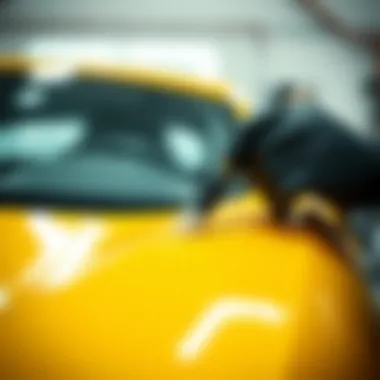
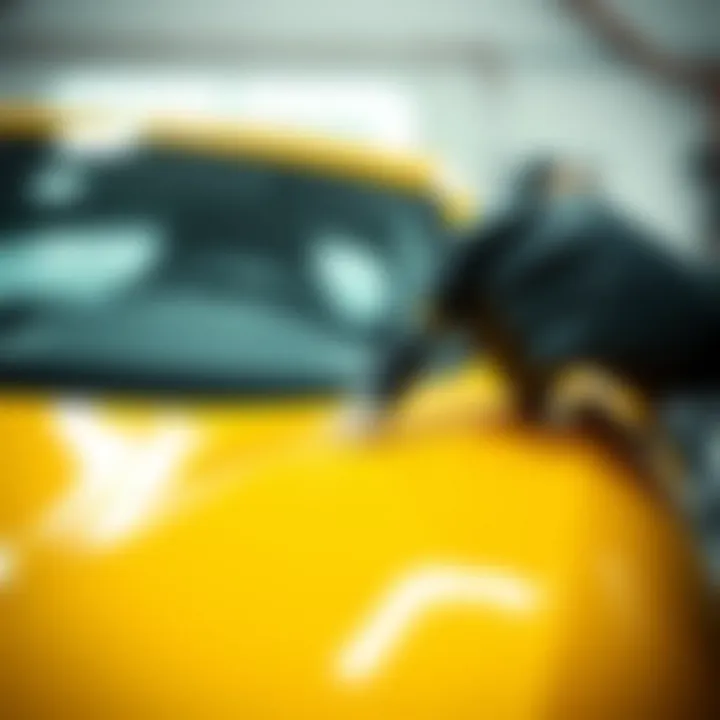
Understanding Color Codes and Matches
Color codes are the foundation of any effective touch-up paint application. Every vehicle manufacturer has a unique paint code that identifies the specific shade and type of paint used on their models. This ensures that the touch-up paint matches the original application almost perfectly. You can usually find this number in places like the owner's manual, the door jamb, or under the hood. Once you have this code, it can be a golden ticket in tracking down the matching paint.
Finding the right match goes beyond just a mere number, though. You must also consider how factors such as wear and tear, fading, and even exposure to elements can alter the appearance of paint over time. New paint might appear shiny against older paint, which has aged. That's why it’s advisable to factor in these aspects during selection. Additionally, many brands now offer re-tintable options that allow for color adjustments, enhancing the likelihood of a match.
"A paint code is like the vehicle's fingerprint; it tells you exactly what shade was meant to be there, providing a pathway to restoration."
To keep it simple, here are some pointers when decoding color matching:
- Inspect Under Good Light: Use natural light to evaluate the scratch and paint around it.
- Use Online Tools: Many paint manufacturers provide online tools or applications to assist in finding the correct color match.
- Sample Swatches: Get sample swatches when possible, as they can offer a more accurate representation than merely looking at a painted surface in a store.
Choosing Between Spray and Brush Applications
When it comes to application methods, the choice between spray paint and brush touch-up paint can be a game changer, depending on the extent of the scratch and the desired finish.
Spray paints are often favored for larger areas or when you want a smooth, even finish. They provide a finer mist that can cover broad surfaces easily, making it ideal for tasks where blending is key. On the downside, they come with their own set of challenges. Wind can easily interfere if you're applying outdoors, and overspray can create unwanted patches where paint shouldn’t be.
On the other hand, brush applications allow for more precision and control. They are typically better for minor scratches, chips, and areas that require meticulous attention, such as around decals or intricate designs. This method ensures you apply exactly where needed without overshoot. However, achieving a smooth finish via a brush requires a steady hand and some practiced technique.
Here's a brief comparison:
- Spray Applications:
- Brush Applications:
- Pros: Quick application, great for large areas, smooth finish.
- Cons: Overspray issues, less control.
- Pros: Precise control, good for detailed areas.
- Cons: Requires patience to achieve a smooth look.
Ultimately, the decision boils down to the situation at hand. Evaluate the severity of the scratch, the painting environment, and your own skill level. For best results, sometimes individuals choose to blend both methods, using spray for larger areas and precision brushes for the fine details. In any case, preparatory steps like cleaning the surface, applying the right undercoat, and ensuring proper drying times will enhance your touch-up paint application, regardless of method.
Touch-Up Painting Techniques
Touching up scratches is more than just a cosmetic fix; it plays a crucial role in maintaining the integrity and value of your vehicle or boat. When left unattended, scratches can lead to rust formation and further deterioration of paintwork, which can be costly to rectify. Effective touch-up painting techniques not only restore the appearance of scratches but also protect against future damage. A well-executed touch-up enhances the vehicle’s aesthetic appeal and prolongs its lifespan, making this a valuable skill for any automotive or boating enthusiast.
Step-by-Step Application Process
Applying touch-up paint isn’t rocket science, but it does require deftness and a structured approach. Here’s a breakdown of the process from start to finish:
- Clean the Area: Start by washing the scratched area with soap and water to remove dirt, grease, and grime. Dry it thoroughly with a microfiber towel.
- Assess the Scratch: Determine if the scratch is superficial or if it has penetrated deeper. This will dictate how much prep work needs to be done.
- Sand if Necessary: For deeper scratches, use a fine-grit sandpaper (around 2000-grit) to smooth the edges of the scratch. Be gentle; the goal is not to create more damage but to prepare the surface for painting.
- Apply Primer: If you've sanded down to the metal, applying a primer is essential. Use a thin layer and let it dry completely according to the manufacturer's guidance.
- Match the Paint: Ensure you have the correct color match for your vehicle or boat. You can usually find the color code on a sticker inside the door frame or in the owner’s manual.
- Dab the Paint: Using a fine paintbrush or the applicator that comes with the touch-up paint, dab the paint into the scratch. Start from the outer edge and work your way in.
- Blend: After applying the paint, use a clean brush or cloth to carefully blend the edges to create a seamless look.
- Let It Dry: Patience is a virtue here — allow your touch-up paint to cure fully. It’s usually best to let it rest for at least 24 hours before handling the area.
- Buff and Polish: After curing, use a rubbing compound or polishing compound with a soft cloth to buff out any rough edges to make the finish smooth.
- Seal with Wax: Finally, applying a good quality wax over the area will help protect your fresh touch-up work from the elements.
With this step-by-step guide, you’re equipped to tackle that scratch head-on. Each step plays a vital role in achieving a flawless finish.
Best Practices for Smooth Finishes
To ensure a professional-looking touch-up job, some best practices can make all the difference:
- Temperature Matters: Apply touch-up paint in comfortable temperatures (between 60°F and 80°F). Extreme temperatures can affect drying time and finish quality.
- Keep it Thin: When applying touch-up paint, thin layers are better than thick globs. Multiple light coats will level out better than one thick application.
- Use the Right Tools: Invest in quality brushes, and consider using a spray can for larger areas. A fine-tipped brush can help maneuver into small scratches more effectively.
- Practice Makes Perfect: If you’re unsure, practice on a piece of scrap plastic or metal before applying to your vehicle or boat. It can help you get a feel for the paint consistency and application technique.
- Finishing Touches: Always finish up with a good polish or wax to integrating your repair into the overall aesthetic of your vehicle.
By following these practices, you'll not only achieve a smooth finish but signal your commitment to maintaining your vehicle’s appearance — a marker of pride for any automotive enthusiast. Avoiding shortcuts in this process makes a world of difference in the long run.
Post-Application Care
Taking adequate steps after applying touch-up paint can make a world of difference in the final appearance and longevity of your repair. The importance of post-application care lies in ensuring that the newly applied paint not only adheres properly but also blends seamlessly with the surrounding area. This subtle yet crucial aspect can breathe life back into a scratched surface, whether it be a vehicle or a boat, while enhancing its overall aesthetic appeal. There are key activities that should be undertaken during this phase, and neglecting them could result in a less than perfect finish.
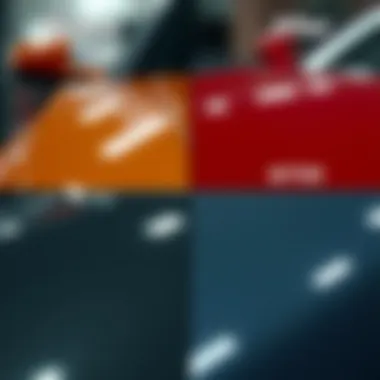
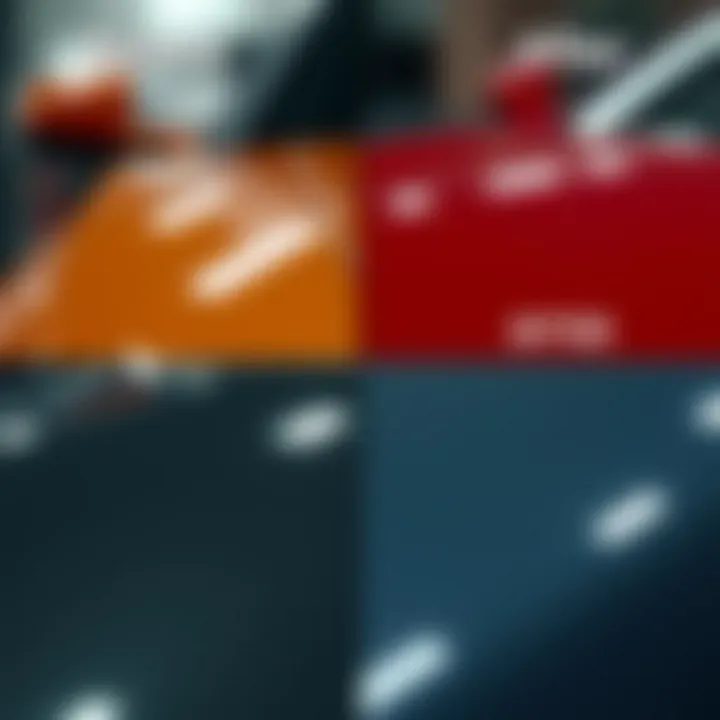
Curing and Buffing the Repair
Curing is a critical step following touch-up paint application. Once you've carefully applied the paint, be it a spray or brush method, it needs time to set and bond with the surface. Generally, it's wise to allow the paint to cure for at least 24 hours before exposing it to harsh conditions. This includes avoiding rain, direct sunlight, or any potential scratches that might occur from everyday encounters.
When you view your repair after a few hours, it may still look a bit rough around the edges. This is where buffing comes in. Once the initial curing period has passed, you can gently buff the area using a microfiber cloth. Not only does this enhance the shine, but it also helps blend the newly painted area with the existing finish. Be gentle, as aggressive buffing can mar the fresh paint.
"A smooth finish can often rely on the final touch; a little care now goes a long way in the long run."
Long-Term Maintenance Tips
Maintaining the finish of your touch-up repair is crucial for ensuring that it stands the test of time. Here are a few useful tips:
- Regular Washes: Keeping your vehicle or boat clean is essential. Use mild soap and water to wash the area where you've applied touch-up paint. Avoid harsh chemicals that could degrade the paint over time.
- Avoid Scratching: Try to be mindful about where you park or how you navigate through tight spaces. Any preventive measures can protect your finish and keep it looking sharp.
- Periodic Inspection: Regularly check the repaired area for signs of wear or damage. Catching issues early could save you from more extensive repairs later on.
- Use a Wax or Sealant: After a month of curing, consider applying a quality wax or sealant to the painted area. This will provide an extra layer of protection against the elements and UV rays.
Organizing a schedule to revisit your repairs can also encourage you to maintain your vehicle or boat in top-notch condition. By considering these maintenance practices, you ensure not just the longevity of your touch-up paint but also maintain the overall aesthetic appeal of your vehicle or boat.
When to Seek Professional Help
In the realm of automotive and marine care, there comes a moment when the DIY approach to dealing with scratches just may not cut it. Understanding when to seek professional help is as crucial as the repair methods themselves. While many minor scratches can be tackled at home with the right touch-up paint techniques, deeper or more extensive damages can require a professional's eye and skill. Recognizing these scenarios not only saves time but can also protect the integrity of your vehicle or boat.
Engaging professionals can bring a wealth of experience that makes a significant difference in the quality of the repair. Skilled technicians have access to advanced tools and products that the average person simply doesn’t. Often, they can handle issues that would be daunting or ineffective for someone without the right training. They see the finer details that an untrained eye might miss, ensuring that repairs blend seamlessly with existing surfaces.
Moreover, professional repairs often come with warranties. This means that should anything go wrong, you have recourse and protection, which is a comfort that DIY repairs can’t always offer. It’s about balancing time, cost, and quality effectively. In some instances, forking out a bit more for expert help could end up saving you money down the line.
When in doubt, consulting with a professional is always wise. They can help determine whether your scratch is an easy fix or if it demands specialized attention.
Indicators for Professional Assessment
Determining whether to call in the pros hinges on recognizing certain indicators. Some scratches might look harmless on the surface, but deeper issues may lie beneath. Here’s a couple of things to consider:
- Depth of the Scratch: If you can catch your fingernail in it, chances are it's deeper than simple surface damage. Such scratches will likely require professional tools and expertise to fix.
- Location of the Scratch: Scratches located on critical areas such as the bumper, near lights, or on curves can often lead to further complications if not treated properly.
- Multiple Scratches or Dents: If you're facing a series of scratches rather than a single one, it might be worthwhile to seek help to ensure all damages are assessed and addressed effectively.
- Paint Issues: If the paint is bubbling, peeling, or showing rust, it's imperative to consult a professional. These symptoms could indicate underlying problems that simple touch-up paint won't fix.
Cost Analysis of DIY vs. Professional Repairs
When weighing the options between a DIY fix and hiring a professional, the costs associated with both alternatives are pivotal in making your decision. Here’s a breakdown:
- DIY Costs:
- Professional Costs:
- Materials such as touch-up paint can range from $10 to $50, depending on the brand and quality required.
- Tools, like sandpaper, clear coat, or polishing compounds, may add another $20 to $100 to your expenses.
- If the process takes longer than anticipated, it can lead to hidden costs, such as additional time taken off work or rental of tools necessary for the job.
- Professional touch-up services can vary widely, starting from $100 and easily reaching $500 for more complex repairs depending on location, the severity of damage, and labor rates.
- The initial investment might seem steep, but a well-done job can boost your vehicle or boat's value significantly, making it a feasible choice.
Closure
The discussion about scratches and effective touch-up paint techniques is not merely academic; it has very real implications for vehicle and boat owners. The aesthetic value of any vehicle is often tied directly to its exterior condition. Thus, knowing how to effectively manage and repair these minor blemishes becomes essential for anyone who values their investment.
Understanding the various types of scratches and their severity allows owners to distinguish between what can be tackled at home and what warrants a visit to a professional. This discernment not only saves money but can also prolong the life of the vehicle's finish, protecting it from further damage. Moreover, touch-up paint techniques learned throughout this article enable individuals to perform repairs with confidence and skill.
"Taking care of scratches isn’t just about looks; it’s a direct reflection of how you value your possession."
When armed with the right tools, materials, and knowledge, vehicle owners can enhance their automobile's appearance and maintain its market value. It’s also rewarding to see a repair done effectively, restoring a sense of pride in ownership. Ultimately, embracing these practices is both a practical approach and a form of self-expression in automotive and marine care.
Summary of Key Points
- Understanding Scratch Severity: Identifying if a scratch is minor or major helps determine the repair strategy.
- Selecting Proper Touch-Up Paint: Matching colors and deciding on application methods are crucial for a great finish.
- Techniques for Application: Knowing the step-by-step process ensures an effective repair, contributing to a smooth and flawless look.
- Post-Application Care: Allowing adequate time for curing and employing regular maintenance helps preserve the repair work.
- When to Seek Professional Help: Recognizing signs that point towards professional intervention can save money and time in the long run.
Final Thoughts on Maintaining Vehicle Aesthetics
Maintaining the aesthetics of a vehicle is a continual process, one that involves awareness, diligence, and proper technique. A well-kept exterior speaks volumes about the owner and the vehicle itself. By committing to consistent care, be it through personal touch-ups or scheduled professional assessments, owners can significantly enhance the longevity and saleability of their assets.
Investing time to learn effective touch-up techniques not only empowers individuals but also fosters a deeper bond with their vehicles and boats. In this era of fast-paced consumption, taking a step back to appreciate and care for one’s possessions is immensely rewarding, ensuring that every scratch isn’t just seen as damage, but as an opportunity for restoration and pride.

